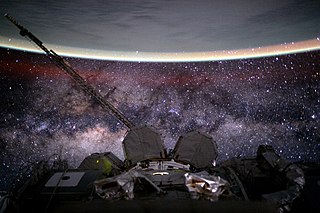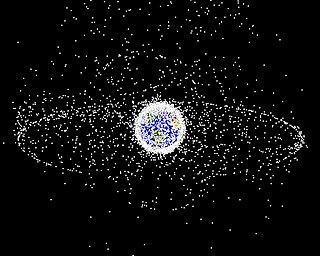
Space colonization is the use of outer space for colonization, such as permanent habitation, exploitation or territorial claims. Extraterrestrial colonization is its broader form, including the use of celestial bodies, other than Earth, for colonization.

Outer space is the expanse beyond celestial bodies and their atmospheres. It contains ultra-low levels of particle densities, constituting a near-perfect vacuum of predominantly hydrogen and helium plasma, permeated by electromagnetic radiation, cosmic rays, neutrinos, magnetic fields and dust. The baseline temperature of outer space, as set by the background radiation from the Big Bang, is 2.7 kelvins.

The Outer Space Treaty, formally the Treaty on Principles Governing the Activities of States in the Exploration and Use of Outer Space, including the Moon and Other Celestial Bodies, is a multilateral treaty that forms the basis of international space law. Negotiated and drafted under the auspices of the United Nations, it was opened for signature in the United States, the United Kingdom, and the Soviet Union on 27 January 1967, entering into force on 10 October 1967. As of March 2024, 115 countries are parties to the treaty—including all major spacefaring nations—and another 22 are signatories.

Space law is the body of law governing space-related activities, encompassing both international and domestic agreements, rules, and principles. Parameters of space law include space exploration, liability for damage, weapons use, rescue efforts, environmental preservation, information sharing, new technologies, and ethics. Other fields of law, such as administrative law, intellectual property law, arms control law, insurance law, environmental law, criminal law, and commercial law, are also integrated within space law.

Colonization of the Moon is a process or concept employed by some proposals for robotic or human exploitation and settlement endeavours on the Moon. Settling of the Moon is, therefore, a more specific concept of lunar habitation, for which the broader concept of colonization is often used as a synonym, a use that is contested in the light of colonialism.
The Agreement Governing the Activities of States on the Moon and Other Celestial Bodies, better known as the Moon Treaty or Moon Agreement, is a multilateral treaty that turns jurisdiction of all celestial bodies over to the participant countries. Thus, all activities would conform to international law, including the United Nations Charter.

Asteroid mining is the hypothetical extraction of materials from asteroids and other minor planets, including near-Earth objects.

Space weapons are weapons used in space warfare. They include weapons that can attack space systems in orbit, attack targets on the earth from space or disable missiles travelling through space. In the course of the militarisation of space, such weapons were developed mainly by the contesting superpowers during the Cold War, and some remain under development today. Space weapons are also a central theme in military science fiction and sci-fi video games.

Space advertising is the practice of advertising in space. This has usually been done with product placements during crewed space missions.
Space jurisdiction, a field addressing what countries can enforce various laws in space, has become more important as the private sector enters the field of space tourism. Under the Outer Space Treaty of 1967, while space and celestial bodies cannot be appropriated by nations, objects launched into space and personnel on board them remain under the jurisdiction of the state of registry.

The Convention on International Liability for Damage Caused by Space Objects, also known as the Space Liability Convention, is a treaty from 1972 that expands on the liability rules created in the Outer Space Treaty of 1967. In 1978, the crash of the nuclear-powered Soviet satellite Kosmos 954 in Canadian territory led to the only claim filed under the convention.
Space policy is the political decision-making process for, and application of, public policy of a state regarding spaceflight and uses of outer space, both for civilian and military purposes. International treaties, such as the 1967 Outer Space Treaty, attempt to maximize the peaceful uses of space and restrict the militarization of space.

The politics of outer space includes space treaties, law in space, international cooperation and conflict in space exploration, international economics, and the hypothetical political impact of any contact with extraterrestrial intelligence.

In archaeology, space archaeology is the research-based study of various human-made items found in space, their interpretation as clues to the adventures humanity has experienced in space, and their preservation as cultural heritage.

Humans have been present in space either, in the common sense, through their direct presence and activity like human spaceflight, or through mediation of their presence and activity like with uncrewed spaceflight, making "telepresence" possible. Human presence in space, particularly through mediation, can take many physical forms from space debris, uncrewed spacecraft, artificial satellites, space observatories, crewed spacecraft, art in space, to human outposts in outer space such as space stations. While human presence in space, particularly its continuation and permanence can be a goal in itself, human presence can have a range of purposes and modes from space exploration, commercial use of space to extraterrestrial settlement or even space colonization and militarisation of space. Human presence in space is realized and sustained through the advancement and application of space sciences, particularly astronautics in the form of spaceflight and space infrastructure.

The Declaration of the First Meeting of Equatorial Countries, also known as the Bogota Declaration, is a declaration made and signed in 1976 by eight equatorial countries, and was an attempt to assert sovereignty over those portions of the geostationary orbit that continuously lie over the signatory nations' territory. These claims have been one of the few attempts to challenge the 1967 Outer Space Treaty, but they did not receive wider international support or recognition. Subsequently, they were largely abandoned.

The space policy of the United States includes both the making of space policy through the legislative process, and the implementation of that policy in the United States' civilian and military space programs through regulatory agencies. The early history of United States space policy is linked to the US–Soviet Space Race of the 1960s, which gave way to the Space Shuttle program. At the moment, the US space policy is aimed at the exploration of the Moon and the subsequent colonization of Mars.

Asgardia, also known as the Space Kingdom of Asgardia and Asgardia the Space Nation, is a micronation formed by a group of people who have launched a satellite into Earth orbit. They refer to themselves as "Asgardians" and they have given their satellite the name "Asgardia-1". They have declared sovereignty over the space occupied by and contained within Asgardia -1. The Asgardians have adopted a constitution and they intend to access outer space free of the control of existing nations and establish a permanent settlement on the Moon by 2043.

Space sustainability aims to maintain the safety and health of the space environment.
Space ethics, astroethics or astrobioethics is a discipline of applied ethics that discusses the moral and ethical implications arising from astrobiological research, space exploration and space flight. It deals with practical contemporary issues like the protection of the space environment and hypothetical future issues pertaining to our interaction with extraterrestrial life forms.
















